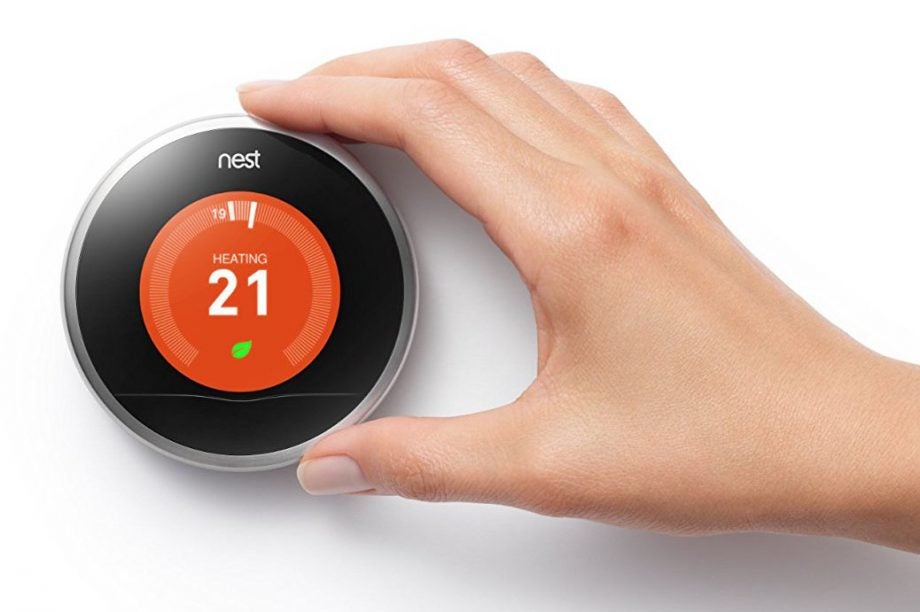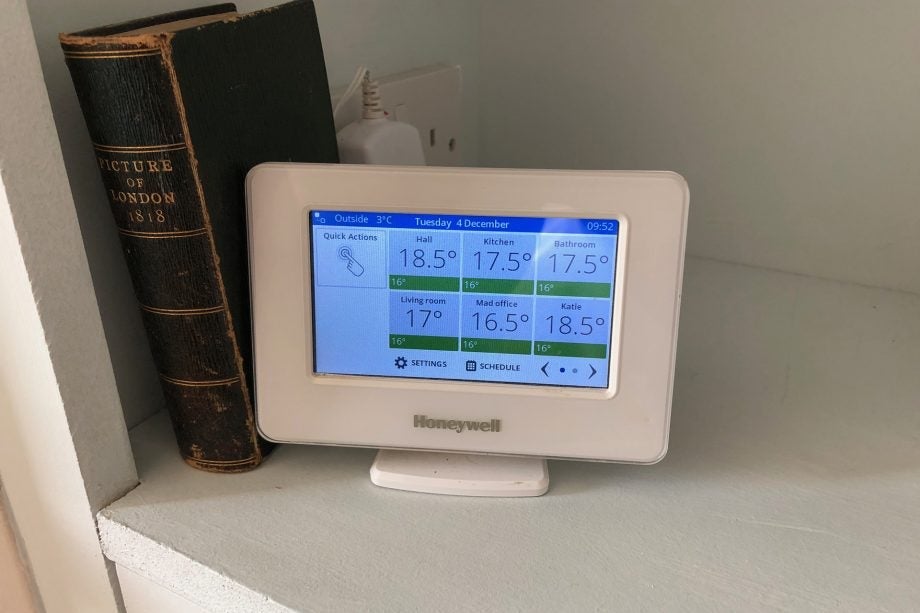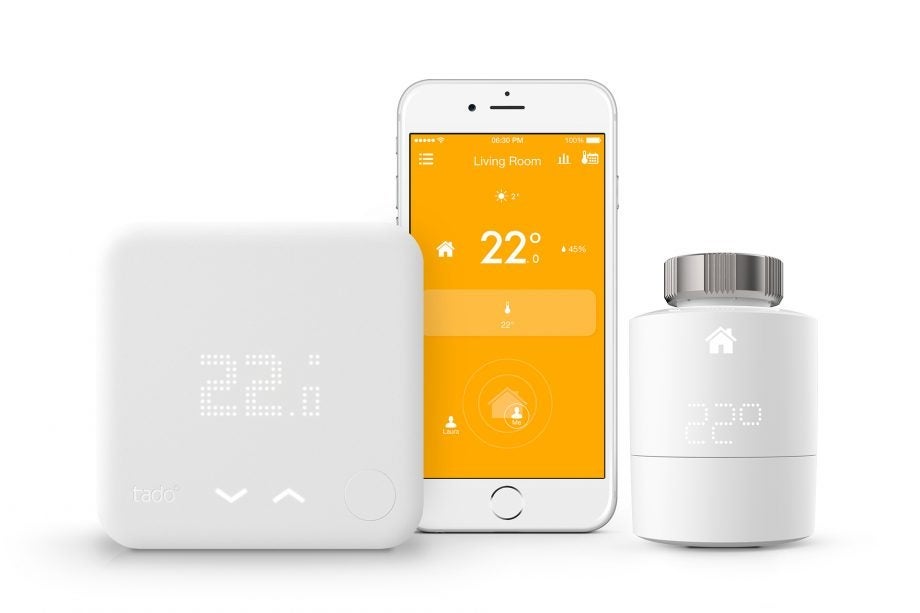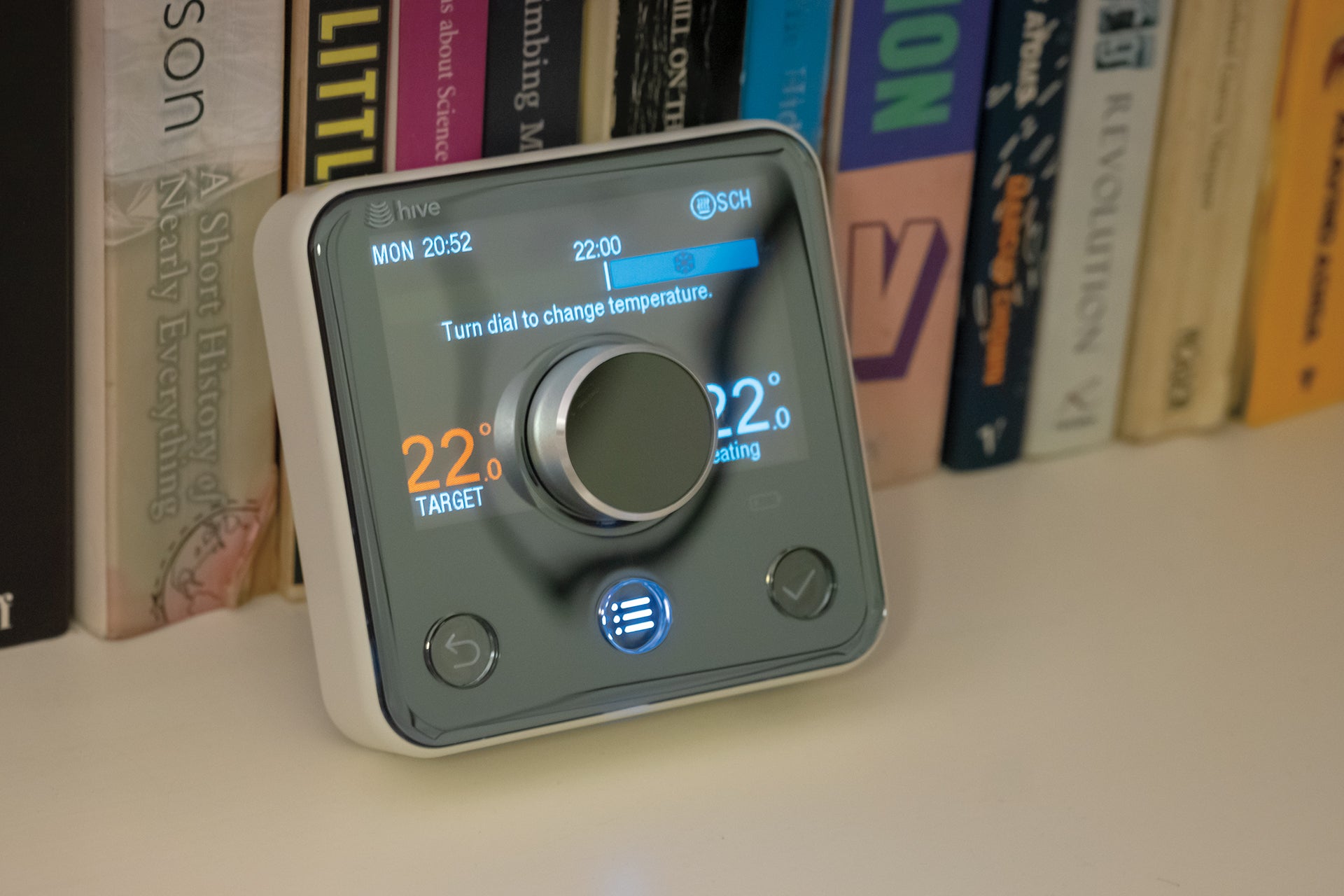Best Smart Thermostat 2024: Stay warm with these intelligent thermostats

If you’re ready to take control of your home or office heating then it might be time to upgrade to one of the best smart thermostats on the market.
While smart home tech is certainly useful for developing a seamless ecosystem that can take several chores out of your hands completely, they can also be a huge help for cutting the costs of your monthly outgoings, and in no piece of tech is that more apparent than with smart thermostats.
These tiny bits of tech may look unassuming but they can go a long way towards helping you stay on top of your home’s heating, therefore lessening any potential wastage of power and having a positive knock-on effect for your bills in the process.
While smart thermostats certainly come into their own during the colder months of winter, they are still helpful all-year round which is why our smart thermostat testing is a bit different to how we review other smart home products.
In order to get a truly comprehensive understanding as to whether a particular smart thermostat is up to the task, our professional testers will aim to use several smart thermostats simultaneously, in different areas of a property for an extended period of time. This means that when you read out smart thermostat reviews, you can get an immediate idea of how each one performs.
Of course, for anyone who doesn’t really have the time to start reading all of our available reviews, we’ve put together this handy list, highlighting the absolute best smart thermostats currently available, all in one place. We’ve also made sure to note what feature or skill each one excels at, so you can quickly find out which one best suits your needs.
If you’re looking to expand your smart home ecosystem beyond heating, we also have round-ups for the best smart plugs and best smart speakers.
Best smart thermostats at a glance
- Best smart heating system: Honeywell Evohome – check price
- Best single smart thermostat: Nest Learning Thermostat – check price
- Best system for flexibility: Genius Hub
- Best HomeKit smart thermostat: Tado Smart Thermostat – check price
- Best simple radiator upgrade: Vestemi Radbot – check price
- Best simple smart thermostat upgrade: Nest Thermostat E – check price
How We Test
Testing smart thermostats is as much about consistency, so I have built a custom rig that lets me wire thermostats into an electric heater, giving me the option to quickly change units. All single thermostats are tested in that way.
For multi-room systems that use radiator valves, I test at the Trusted Reviews home appliance lab, which has three radiators that I can individually control.
I test for quality, ease of use, ability to maintain temperatures, and how the systems interact with other smart systems, including Alexa, SmartThings, IFTTT and so on.
- Extremely flexible
- Touchscreen controller
- Powerful Quick Actions
- No geolocation
- Expensive
- Looks fantastic
- Learns how you use it
- Sharp and clear display
- Can’t expand to radiator control
- Extremely flexible and can handle multiple heating types
- Very quiet radiator valves
- Motion sensors help control costs
- Learns your habits
- Amazon Alexa and Google Assistant support (via IFTTT)
- Better for larger homes
- Slightly fiddly app control for overriding temperatures
- Excellent app
- High-quality thermostat and radiator valves
- Easy to programme
- Clever energy saving
- Extension kit for hot water is expensive
- Plug-in bridge seems superfluous
- Have to pay or geolocation and open-window detection
- Great value
- Very little configuration
- Easy to install
- No boiler control
- No manual scheduling
- Easy to install
- Diffused screen helps thermostat blend in
- Pre-programmed schedule
- Assisted install in app can be finicky
- No hot water support

Honeywell Evohome
The best smart heating system
Pros
- Extremely flexible
- Touchscreen controller
- Powerful Quick Actions
Cons
- No geolocation
- Expensive
No company has as much experience in the heating arena as Honeywell, so it’s no surprise that its first smart product offering has been extremely comprehensive. Rather than replacing your basic smart thermostat, the Honeywell Evohome adds room-by-room control through smart TRVs, but also supports underfloor heating and even heat pumps.
Although this adds to the initial set-up cost – you’ll need a £59 TRV per radiator – it should save money thereafter, since you’ll only need to heat the rooms you’re using. Also, each room is set to its perfect temperature, making for a more comfortable home environment. You can even go beyond radiator control with support for underfloor heating and zone controls, too.
The level of control on offer is impressive, with the ability to set schedules per room. We love the Quick Actions, too, which let you make system-wide changes at the touch of a button, such as turning on the Economy mode (three-degrees colder in each room) to save money when you go out. There’s support for Google Assistant and Amazon Alexa, too. A recent addition is weather compensation, which can dial your heating up or down based on the temperature outside. It works brilliantly, making our home more comfortable.
Evohome continues to be a powerful multi-room system, ideal for larger homes featuring a range of heating sources.
Reviewer: David Ludlow
Full review: Honeywell Evohome review

Nest Learning Thermostat
The best single smart thermostat
Pros
- Looks fantastic
- Learns how you use it
- Sharp and clear display
Cons
- Can’t expand to radiator control
The Nest Learning Thermostat is among the best-known smart thermostats around, and for good reason. This product has shown how powerful smart heating can be. Now in its third generation, it remains one of the best smart thermostats you can buy.
As the name suggests, the thermostat learns how you like your home heated, using this information to create an automatic schedule for you. Not surprisingly, there’s an initial learning curve – in the first few weeks, the Nest may not work quite the way you want it to. Over time, however, it should prove more effective than a manually set schedule on rival thermostats. In addition, the thermostat uses presence detection to turn on and off automatically, depending on whether anyone is at home.
With support for Amazon Alexa and Google Home (although HomeKit support doesn’t seem likely), Nest covers the basics; since Google turned off the Works with Nest programme, though, the thermostat has lost a few features.
This latest version supports dual-zone plumbing and can be extended to support hot water systems as well. Note that there are no smart radiator valves to add full zoning, however.
Reviewer: David Ludlow
Full review: Nest Learning Thermostat review

Genius Hub
The best system for flexibility
Pros
- Extremely flexible and can handle multiple heating types
- Very quiet radiator valves
- Motion sensors help control costs
- Learns your habits
- Amazon Alexa and Google Assistant support (via IFTTT)
Cons
- Better for larger homes
- Slightly fiddly app control for overriding temperatures
If you’re looking for the most powerful and flexible heating system, then the Genius Hub should be top of your list. Designed and built by a UK company, this is a seriously impressive heating system that can control practically all types of heat source, from combi boilers to electric. As you’d expect from such a system, control over individual rooms comes courtesy of smart radiator valves.
Genius Hub goes further than the competition, thanks to its motion sensors. In the app, you can use the motion sensors to automatically set up a heating schedule via room occupancy (Footprint mode, which is free forever), or you can use the new Sense mode (subscription required) to set a schedule as standard; but you can also choose to use the motion sensor to only turn on the heat when there’s someone in the room. For example, you could set your living room to use the motion sensor during the day, so if you do have the day off work then your heating can be set to turn on automatically. That’s what we call smart.
There’s an Amazon Alexa skill, but no dedicated Google Assistant skill – although you can connect the system via IFTTT for some basic control here. A high price may put off some, but the Genius Hub system is designed for the largest homes or for those wanting the biggest savings. In our experience, Genius Hub works brilliantly and is worth every penny.
Reviewer: David Ludlow
Full review: Genius Hub review

Tado Smart Thermostat
The best HomeKit smart thermostat
Pros
- Excellent app
- High-quality thermostat and radiator valves
- Easy to programme
- Clever energy saving
Cons
- Extension kit for hot water is expensive
- Plug-in bridge seems superfluous
- Have to pay or geolocation and open-window detection
Tado launched with the goal of making smart heating systems easy to use, and it certainly succeeded. The Tado Smart Thermostat is designed to track your location so that your heating goes off when you’re out and turns back on when you’re on the way home. It works brilliantly and has the most reliable presence detection we’ve tested.
Since launch, Tado has updated the apps and web interface to add a new heating scheduler, so you can choose the home temperature that you want hour by hour. There are also options for when you’re out – choose from maximum savings (which may mean you return to a colder home) or maximum comfort (you’ll spend more to keep your home warmer). The app is simple to use, making the Tado Smart Thermostat one of the easiest systems to program.
Tado’s system is also super-flexible. With the launch of its smart radiator thermostats, the system can be as powerful as Evohome’s. However, Tado’s radiator valves aren’t quite as smart, and the app’s zone handling isn’t quite as easy to use as that of Honeywell.
The addition of Amazon Alexa and Google Home support, IFTTT and HomeKit (via the V3+ internet bridge) make Tado’s Smart Thermostat one of the most powerful available. The downside is that the new system requires a monthly subscription to enable automatically turning off of the heating when you go out, plus the window-detection feature, which turns off the heating when a door or window is open.
By thinking of the subscription as payment towards ongoing development of the app and system makes it easier to accept. And you may decide you only need to pay for the extra features during the winter months, as you can cancel your subscription at any point.
Reviewer: David Ludlow
Full review: Tado Smart Thermostat review

Vestemi Radbot
The best simple radiator upgrade
Pros
- Great value
- Very little configuration
- Easy to install
Cons
- No boiler control
- No manual scheduling
Most smart heating systems require an app to provide fancy programming options. That’s all well and good, but it can make things complicated. The Vestemi Radbot is different: this smart radiator valve learns how you use a room automatically via its sensors, and then controls your heating automatically.
The Radbot looks like a standard TRV, and has a simple control dial that moves from 1 to 5 – these numbers correspond to a room temperature of between 15ºC and 24ºC. It would have been easier if Vestemi had put the temperatures on the dial, to be honest. But that’s our only criticism; otherwise, Radbots are brilliant.
The system learns how you use a room by tracking how light changes during the day – such as when you open the curtains, or turn the lights on and off. It turns the heating up when you’re in a room, and down when you’re not. And if you get cold, there’s a boost button. Even better, the Radbot works with your existing heating system, so there’s nothing to hook up to the boiler. If you want a smart solution that’s simple and cheap, this is the product for you.
Reviewer: David Ludlow
Full review: Vestemi Radbot

Nest Thermostat E
The best simple smart thermostat upgrade
Pros
- Easy to install
- Diffused screen helps thermostat blend in
- Pre-programmed schedule
Cons
- Assisted install in app can be finicky
- No hot water support
Forget expensive installations and hassle – the Nest Thermostat E has been designed so that pretty much everyone should find it easy to install. The new Heat Link E battery-powered bridge attaches to the wires that were used by your old wired thermostat – and that’s it. Starting from scratch, most people should have the system up and running in under an hour. If you don’t have a wired thermostat, you’ll need to have the Heat Link E wired into your boiler, which will most likely mean a professional installation. While the system supports OpenTherm for increased energy savings, at this point your best option is probably a different product.
Nest has pre-programmed the Thermostat E with a schedule based on real data from existing Nest users. As you use the thermostat, it learns and updates your schedule.
The main thermostat has a diffused screen, helping it blend into the background. The screen displays the temperature, and you can use the outer dial to adjust it. The excellent Nest app provides even greater control, adding features such as geolocation to turn off your heating when you go out. True Radiant learns how your house warms up, so you can have it warm when you need to, and avoid overshooting your desired temperature.
If you’re looking for a simple, smart upgrade to an existing dumb, wired thermostat, then this is a great choice.
Reviewer: David Ludlow
Full review: Nest Thermostat E review
FAQs
There are numerous smart thermostats to choose from, each offering a variety of features, so it’s important to pick the one that suits your lifestyle and home. First, you need to consider the type of heating system you want. A regular smart thermostat simply replaces your existing thermostat. You’ll still save money with such a system, but your heating settings will be applied to your entire home.
A zoned heating system offers room-by-room control via smart thermostatic radiator valves (TRVs). Such a system will save you more money since you’ll be heating only the areas you’re using at any given time. The downside is that the initial outlay for such systems can be costly: typically around £50 to £70 per radiator. They’re a better option for houses with a greater number of rooms.
All smart thermostats should be controllable, to a degree, from the main unit as well as from a dedicated smartphone app. Voice control is becoming a more important feature, in the form of Alexa on the Amazon Echo, Google Assistant or Siri using Apple HomeKit.
Being able to simply tell your thermostat to turn the heating up or down is a convenient way to control the temperature in your home. Alexa and Google Assistant support is more widespread, with HomeKit support lagging somewhat.
This is the ability, particularly for smart radiator valves, to turn on your heating when they’re too cold. An increasing number of smart radiator valves can’t “call for heat”.
Instead, they offer finer control over a room’s temperature than a traditional mechanical thermostat, which will simply let you set your controls between one and five without giving you any indication what this means. Smart valves shut down radiators when the desired temperature has been reached.
So, why would you want to go down this route? If you have an old boiler that you can’t upgrade, or you’re a renter who isn’t in control of overhauling the smart heating system, these options can be a helpful addition. And if you’re looking for greater control over an existing smart thermostat that doesn’t offer its own smart TRVs as an upgrade then such devices can be useful.
In short, yes. According to Tado, UK customers can save up to 19% on heating costs in comparison to the costs of using a traditional dumb thermostat and normal heating controls, as our full guide to how much money a smart thermostat can save you explains
OpenTherm is a protocol that allows a boiler to modulate. That is, the thermostat tells the boiler how much heat is required based on the current demand, and then the boiler lowers or increases the temperature of the water it pushes around the system automatically. This helps save another few percent on energy bills. However, to get OpenTherm to work, you need to have a boiler that supports it and a smart thermostat that supports it, too. Most modern thermostats do, but if you’ve got an older boiler, you may find that it’s not so well supported.
Some can, some can’t. If you have underfloor heating, and want to control it individually, you’ll need a system that supports this, such as Honeywell Home Evohome, Genius Hub or Tado.
Many thermostats have been updated to support the running of heat pumps, including Evohome. Heatpump support is important to get maximum savings. Generally speaking, heat pumps are at their best when running at lower temperatures for longer to heat your house; they can be set to use more energy to heat water to higher temperatures to increase heating times. A smart thermostat needs to understand both the system it’s connected to and how you want it to run, so you can choose between the best savings or the quickest heating times. If you’re getting a heat pump, then make sure you buy a smart thermostat or heating system that is compatible with it.










